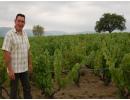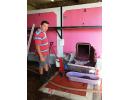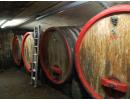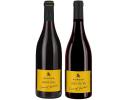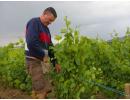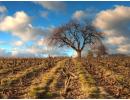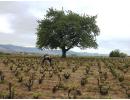Laurent Gauthier
Laurent Gauthier "Grand Cras" Vieilles Vignes - Morgon
The wine is named after the lieu-dit "Grand Cras" located at the foot of the hill Côte du Py. The estate's parcel represents 8.40 hectares of 70 years old Gamay vines planted on decomposed granite. The average yield is 50hl/ha. Between 30% to 80% of the grapes are destemmed depending on the vintage and the structure sought. The classic fermentations will take 10 to 15 days in concrete vats involving some pigeage. The ageing will be short using large oak vats for a period of 3 to 4 months to retain the characteristics of the Gamay grape and its terroir.
PVins notes: The expressive nose shows redberries with hints of kirsch, the palate is well-structure with elegant tannins and minerality on the long finish. The wine may be cellared for up to 10 years depending on the vintage.
The family Gauthier has a long history in the area as a Mr Benoît Gauthier was already working in the vineyards of Chiroubles in 1720. The estate located in Morgon has been in the family since 1834. Laurent Gauthier, representing the 6th generation, was born in 1965 and Following his viticulture diploma in 1983 he started with his own estate of 2.5 hectares. In 1991 he took over the family's estate from his parents and joined the two properties. He sons Jason and Elie now also help him in the running of the Domaine. Laurent is very demanding and a perfectionist, driven by his passion he is not afraid to break his back doing the job always striving to rich a high standard of quality.
French version - featuring Laurent Gauthier
Laurent owns 11.65 hectares of old vines averaging 70 years of age, located in 2 "village cru" appellations which are Morgon and Chiroubles. The parcel in Chiroubles is 1.42 hectares in size located in the lieu-dit "Châtenay" with sandy-granitic soils. The heart of the Domaine is in Morgon with its 2 parcels located in the areas of "Grand Cras" representing 8.40 hectares on decomposed granite towards the bottom of the "Py" hill at 220 metres in altitude and the "Côte du Py" with its 1.83 hectares situated towards the top of the hill. The jewel of the estate is the "Côte du Py" located just below the one and only tree on the hill at 260 metres in altitude, facing south on blue schist granite. The vineyard is planted with 10,000 vines per hectare, every second row is planted with grass to maintain biodiversity and the health of the vineyard.
The 70 years old Gamay grapes are handpicked and brought to the sorting table at the cellar. Depending on the vintage and the wine 30% to 80% of the bunches will be destemmed. The portion of whole bunches left will bring extra tannins for the structure and balance to the wines. The average yield is 50 hl/ha. The fermentation are carried out in concrete vats at 20°C - 25°C which will last from 10 to 16 days. There is no carbonic maceration just classic winemaking techniques. The wines are aged in large oak barrels for 3 to 4 months before fining.
Laurent produces two Morgon wines that are well structured and balanced with fruit driven aromatic complexity. The "Grand Cras", named after the lieu-dit, is very pleasant and fruity in its youth, while the cuvée "Côte du Py" requires a little cellaring in its youth to soften its tannins. The latter will evolve very well up to 15+ years in classic vintages. In a blind tasting you might be a little disorientated thinking you are in the heart of Burgundy with a very good Pinot Noir.
French version (english subtitles)
BEAUJOLAIS MORGON
Links: AOP Morgon - Beaujolais map - www.beaujolais.com
MORGON - BEAUJOLAIS
The Beaujolais region stretches for 55 kilometres from the south of the Mâcon wine region to the north of the city Lyon. The region is a sub-region of Burgundy and the furthest to the south covering 22,500 hectares. The appellations were originally established in 1936, with additional "crus" being promoted in 1938, 1946 and 1988.
History
The area was first cultivated by the Romans who planted the areas along its trading route up the Saône valley. The most noticeable Roman vineyard was Brulliacus located on the hillside of Mont Brouilly, vineyards were also planted in the area of Morgon. From the 7th century through to the Middle Ages, most of the viticulture and winemaking was done by the Benedictine monks. In the 10th century, the region got its name from the town of Beaujeu and was ruled by the Lords of Beaujeutill the 15th century when it was ceded to the Duchy of Burgundy. But later, the Dukes of Burgundy band the Gamay grape from the heart of Burgundy as not to damage their reputation and image, as they were known to produce the best wines in Christendom with the Pinot Noir varietal. The wines were mostly confined to the markets along the Saône and Rhône rivers, particularly in the town of Lyon. In the 19th century, the expansion of the French railroad system opened up the lucrative Paris and exports markets such as England.
Vineyard
The Beaujolais's highest altitude is 1,000 metres with vineyards planted between 200 metres and 500 metres in altitude facing east, south and south-east. The region has a complex soil structure made of clayey-limestone, sandstone, schist and granitic soils. The northern half of Beaujolais, where most of the 10 Cru Beaujolais communes are located, includes rolling hills of schist and granite based soils with some limestone. On hillsides, most of the granite and schist is found in the upper slopes with the lower slopes having more stone and clay composition. The southern half of the region has flatter terrain with richer sandstone and clay based soils with some limestone patches. These soils differences produce different styles of Beaujolais with more structured, complex wines in the north and more lighter, fruity wines in the south.
The Beaujolais region is planted with the grapes Gamay and Chardonnay, the Gamay representing 99% of the appellation's plantation. In contrast to the Pinot noir, Gamay ripens two weeks earlier and is less difficult to cultivate. The best quality Gamay come from the 10 villages known as "Cru" located in the northern part of the Beaujolais region. These 10 Crus have their own appellation named after their village: Morgon, Brouilly, Côte de Brouilly, Chénas, Moulin à Vent, Saint Amour, Regnié, Chirouble, Fleurie and Juliénas. The hierarchy in quality for the 12 Beaujolais appellations is: Beaujolais, Beaujolais Villages and at the top the 10 Crus villages Morgon, Brouilly etc... The 10 Crus represent the pinnacle potential of the Gamay grape, especially when planted on granite and schist based terroirs. Of course there is also the simple quaffing "Beaujolais Nouveau" which is more of a marketing stunt to promote the region, it is released on the market at 00:01am on the 3rd Thursday of November.
Basic Beaujolais Nouveau is meant to be drunk within 6 months of its release and Beaujolais within about a year. Beaujolais-Villages are generally consumed within 2–3 years and the 10 Cru Beaujolais have the potential to age longer, some are not even fully developed until at least 3 years after harvest. Premium examples from Chénas, Juliénas, Morgon and Moulin-à-Vent can be cellared for up to 10 years and more continuing to develop in the bottle and in excellent vintages they can even take on Burgundian qualities of structure and complexity.
Climate
The regions climate is semi-continental with some temperate influences. The proximity of the Mediterranean Sea to the south does bring some Mediterranean influence on the climate. The region is overall, warmer than Burgundy enabling the grapes to reach full ripeness. By late November, the foothills of the Massif Central in the western region will normally have some snow and a common viticultural hazard in spring is the possibility of frost.



